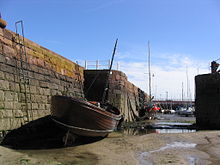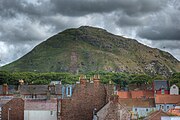North Berwick: Difference between revisions
Lexxxicide (talk | contribs) |
No edit summary |
||
| Line 5: | Line 5: | ||
|gaelic_name= Bearaig-a-Tuath |
|gaelic_name= Bearaig-a-Tuath |
||
|scots_name= |
|scots_name= |
||
|map_type= |
|map_type= |
||
|latitude=55.98 |
|latitude=55.98 |
||
|longitude=-2.78 |
|longitude=-2.78 |
||
Revision as of 11:03, 29 December 2010
North Berwick
| |
|---|---|
| Population | 6,223 |
| OS grid reference | NT555855 |
| Council area | |
| Lieutenancy area | |
| Country | Scotland |
| Sovereign state | United Kingdom |
| Post town | North Berwick |
| Postcode district | EH39 |
| Dialling code | 01620 89xxxx |
| Police | Scotland |
| Fire | Scottish |
| Ambulance | Scottish |
| UK Parliament | |
| Scottish Parliament | |
The Royal Burgh of North Berwick is a seaside town in East Lothian, Scotland. It is situated on the south shore of the Firth of Forth, approximately 25 miles east of Edinburgh. North Berwick became a fashionable holiday resort in the 19th century because of its two sandy bays, the East (or Milsey) Bay and the West Bay, and continues to attract holiday makers to this day. Golf courses at the ends of each bay are open to visitors.
History

The name North Berwick means North 'barley farmstead'. Bere in Old English means 'barley' and wic in Old English is 'farmstead'. The word North was applied to distinguish this Berwick from Berwick-upon-Tweed, which throughout the Middle Ages the Scots called South Berwick. It was recorded as Northberwyk in 1250. On the south of Berwick Law there is evidence of at least eighteen hut circles, rich middens and a field system dating from 2000 years ago.


North Berwick Harbour was built in the 12th century, and for 500 years there was a ferry crossing to Earlsferry, near Elie in Fife. This was popular with pilgrims to St Andrews. This ferry was recently reinstated; during the summer a boat travels between North Berwick and Anstruther in Fife, in homage to the original ferry. Excavations have shown there was activity at the harbour area from as early as the 8th century, while the "Auld Kirk Green" at the harbour was used for gatherings by the accused in the North Berwick Witch Trials. Legend has it that "Satan himself" attended a ritual there in 1590, although it is more likely that Satan was "played" by Francis Stewart Hepburn, 5th Earl of Bothwell. During the 16th century at least 70 people were implicated in the Witch Trials, and the events inspired works such as Burns' "Tam o' Shanter" and "The Thirteenth Member" by Mollie Hunter. One of the most famous Witch trials at North Berwick was of the woman named Agnes Sampson. She was accused of making a potion to make the storms rough as King James VI of Scotland was sailing home from Denmark with his new wife, Anne of Denmark. The trial took place in 1591 and King James was there himself. Sampson was tortured to confess and then burned at the stake, like many other innocent women.

English invaders in the Middle Ages led to the construction of nearby Tantallon Castle, and St Mary's Priory, nunnery, was built at North Berwick. The late 19th century saw North Berwick develop golfing and holiday facilities.
The size and population of the town remained fairly steady until the 1970s, at which point housebuilding began in earnest around the periphery of the town, first to the south (1950s-70s), then a series of major expansions to the west (1980s-present) along the line of the railway. There is talk of further developments focussing on "affordable housing" on the south side of the town. While the population might not have truly "exploded", house prices have. North Berwick consistently appears at the top of national house price surveys, and like-for-like prices are comparable to Edinburgh. North Berwick was listed as the most expensive seaside town in Scotland in 2006, and was second to St. Andrews in 2009.[1][2]
Islands

Several of the Islands of the Forth are near the town and visible from it: e.g. Fidra, The Lamb, Craigleith, and Bass Rock; the latter hosts a thriving colony of birds, including puffins, gannets, and other seabirds. The Bass Rock appears white, but this is due largely to the gannets and their guano that cover much of its surface. The seabirds themselves can be observed at close range through remote cameras operated from the recently developed Scottish Seabird Centre near the harbour.
Attractions


- Boat trips to the Bass Rock, Fidra and other islands.
- Scottish Seabird Centre - Visitor centre about seabirds found on Bass Rock and elsewhere.
- North Berwick Law - A 613-foot (187 m) volcanic hill which rises above the town, with a Napoleonic era signal station. The whale's jawbone "arch" at the summit collapsed in June 2005, and was eventually replaced by a fibreglass replica in June 2008.

North Berwick Law seen from the seafront of North Berwick - Beaches - One of North Berwick's main attractions, the beaches have golden sands and rocks, and a tide-filled boating pond/paddling pool on the East Sands.
- Seacliff. Just to the east of the town, an entry fee is charged at this private and largely unspoilt beach and estate.
- Golf - There are two golf courses in the town, the West Links and the Glen, or East Links, and numerous others in the surrounding area. There are also two 18-hole putting greens and a Golfing Heritage Trial to follow through the town.
- Tennis - Venue for the annual East Lothian Open Tennis Tournament.
- The East Lothian Yacht Club hosts many national and international sailing events.
- The John Muir Way, the East Lothian coastal path, passes through the town.
- Tantallon Castle, a mostly ruined 14th-century fortress in the care of Historic Scotland, is 3 miles east of North Berwick.
Transport
The town is served by North Berwick railway station. The North Berwick Line has provided a rail link with Edinburgh since the 19th century and the line, now operated by First ScotRail, is still the principal transit link between the town and the capital. The service takes 33 minutes and runs hourly with extra trains during peak commuting periods and on Saturdays. Combination rail-and-entry tickets for the Scottish Seabird Centre are available. There is occasional service through to Glasgow Central station on weekdays although anyone heading for central Glasgow is advised to switch to the Edinburgh - Glasgow Queen St. service. First has a monopoly on public transport between North Berwick and Edinburgh as they also operate the bus route which has a similar frequency and a journey time of 1 hour. Edinburgh is the nearest airport, approximately a 45 minute drive or around 80 minutes by public transport.
Within the town there is an hourly bus service which runs on a loop from the High Street (Church St. bus stop) to the recreation ground and back before continuing on to Edinburgh. There is also a seasonal park-and-ride and local services to attractions such as the Museum of Flight(Not current 2010 season). Several taxi operators charge £3 and up for runs around town and more to nearby towns.
Literary links
Robert Louis Stevenson (1850–1894), spent many holidays in the town as a child and young man. His father, Thomas Stevenson the famous engineer and lighthouse builder took his family to stay in various locations in the town. The island of Fidra is said to be the original inspiration for Treasure Island, and much of his novel Catriona (the sequel to Kidnapped) is set locally.
The Scottish author William Dalrymple (born 1965), whose work primarily focuses on British India, has roots in the town, with his family having once owned much of the area. William's father Sir Hew Fleetwood Hamilton-Dalrymple (born 1926) is the current and 10th Baronet of North Berwick. William is the youngest of four brothers.
Notable residents
- Hew Dalrymple, Lord North Berwick (d. 1737), Lord President of the Court of Session
- David Huish, a professional golfer with several wins on the European Seniors Tour. He once led The Open Championship at the halfway stage.
- Catriona Matthew, a professional golfer with 7 professional victories, including the Women's British Open in 2009, and 5 Solheim Cup appearances.
- Ben Sayers, a renowned golfer, golf course architect and golf club manufacturer. A statue of Sayers can be seen outside the Ben Sayers & Son factory.
- Willie Anderson - Date of birth; October 21st 1879, North Berwick, Scotland. Four times U.S. Open Golf Champion 1901,1903,1904 & 1905. Only person to achieve three in a row. Died age of 31 in U.S. ref World Golf Hall Of Fame
Royal visit
HRH Her Majesty The Queen and HRH The Duke of Edinburgh visited the town on 2 July 2009. The Queen presented the Scottish Seabird Centre with the Queen’s Award for Enterprise and unveiled a plaque commemorating the day. The Queen arrived in the royal helicopter, landing on the rugby playing fields, and was transported to and from there by car.
See also
References
- ^ "House prices rise beside seaside". BBC News. 26 May 2006. Retrieved 7 July 2009.
- ^ "North 'cheapest for seaside home'". BBC News. 3 July 2009. Retrieved 7 July 2009.
- "Census 2001". Population figures. Archived from the original on April 26, 2005. Retrieved August 17, 2005.
- Town History
External links
- North Berwick website
- North Berwick Harbour
- North Berwick High School
- Sula II Seabird Boat Trips
- The Glen Golf Club

